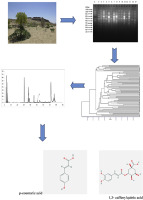当前位置:
X-MOL 学术
›
Phytochemistry
›
论文详情
Our official English website, www.x-mol.net, welcomes your feedback! (Note: you will need to create a separate account there.)
Genetic diversity among and within Ferula asafoetida H. Karst. populations using molecular and phytochemical markers
Phytochemistry ( IF 3.8 ) Pub Date : 2018-11-01 , DOI: 10.1016/j.phytochem.2018.07.004 Pooneh Tajbakht , Majid Talebi , Mehdi Rahimmalek
Phytochemistry ( IF 3.8 ) Pub Date : 2018-11-01 , DOI: 10.1016/j.phytochem.2018.07.004 Pooneh Tajbakht , Majid Talebi , Mehdi Rahimmalek

|
Ferula asafoetida is an herbaceous, perennial and monocarpic species of the Apiaceae family with medicinal properties. In this study, the genetic diversity of F. asafetida populations was assessed using SCoT and SRAP molecular markers. Nine SCoT and nine SRAP primer combinations amplified 211 and 194 bands, showing 96.07% and 92.87% of polymorphism, respectively. The dendrograms generated from Jaccard's similarity matrix and the UPGMA method revealed that genetic relationships among the F. asafoetida genotypes were not related to their geographical regions. The analysis also revealed a relatively acceptable differentiation in allele frequencies, illustrating the high genetic diversity and gene flows among the populations. The high percent of diversity among the populations indicated a rich resource of germplasm for breeding programs. Moreover, STRUCTURE analysis showed the high admixture of the studied accessions. According to AMOVA analysis, higher genetic variation occurred within the populations. Total phenolic content was also assessed using the folin-ciocalteu method, observing a relatively extent variety (0.163-0.938 mg TA/g DW) among the populations. In addition, HPLC analysis defined eleven compounds in which p-coumaric and 1,3- caffeoylquinic acids were the most abundant phenolic acids. Finally, Feragheh population possessed the highest TPC (total phenolic content) and gene diversity. Karaj population also exhibited the highest amount of flavonoids and phenolic acids such as kaempferol and p-coumaric acids.
中文翻译:

Ferula asafoetida H. Karst 之间和内部的遗传多样性。使用分子和植物化学标记的种群
Ferula asafoetida 是伞形科的一种草本、多年生和单果树种,具有药用价值。在这项研究中,使用 SCoT 和 SRAP 分子标记评估了 F. asafetida 种群的遗传多样性。9 个 SCoT 和 9 个 SRAP 引物组合分别扩增了 211 个和 194 个条带,分别显示了 96.07% 和 92.87% 的多态性。从 Jaccard 相似矩阵和 UPGMA 方法生成的树状图显示,细辛基因型之间的遗传关系与其地理区域无关。分析还揭示了等位基因频率的相对可接受的差异,说明种群之间的高遗传多样性和基因流动。种群间的高度多样性表明育种计划的种质资源丰富。而且,结构分析显示所研究种质的高度混合。根据 AMOVA 分析,种群内发生了更高的遗传变异。还使用 folin-ciocalteu 方法评估了总酚含量,观察到种群之间存在相对程度的变化(0.163-0.938 mg TA/g DW)。此外,HPLC 分析确定了 11 种化合物,其中对香豆酸和 1,3- 咖啡酰奎宁酸是最丰富的酚酸。最后,Feragheh 种群拥有最高的 TPC(总酚含量)和基因多样性。Karaj 种群还表现出最高量的类黄酮和酚酸,如山奈酚和对香豆酸。还使用 folin-ciocalteu 方法评估了总酚含量,观察到种群之间存在相对程度的变化(0.163-0.938 mg TA/g DW)。此外,HPLC 分析确定了 11 种化合物,其中对香豆酸和 1,3- 咖啡酰奎宁酸是最丰富的酚酸。最后,Feragheh 种群拥有最高的 TPC(总酚含量)和基因多样性。Karaj 种群还表现出最高量的类黄酮和酚酸,如山奈酚和对香豆酸。还使用 folin-ciocalteu 方法评估了总酚含量,观察到种群之间存在相对程度的变化(0.163-0.938 mg TA/g DW)。此外,HPLC 分析确定了 11 种化合物,其中对香豆酸和 1,3- 咖啡酰奎宁酸是最丰富的酚酸。最后,Feragheh 种群拥有最高的 TPC(总酚含量)和基因多样性。Karaj 种群还表现出最高量的类黄酮和酚酸,如山奈酚和对香豆酸。Feragheh 种群拥有最高的 TPC(总酚含量)和基因多样性。Karaj 种群还表现出最高量的类黄酮和酚酸,如山奈酚和对香豆酸。Feragheh 种群拥有最高的 TPC(总酚含量)和基因多样性。Karaj 种群还表现出最高量的类黄酮和酚酸,如山奈酚和对香豆酸。
更新日期:2018-11-01
中文翻译:

Ferula asafoetida H. Karst 之间和内部的遗传多样性。使用分子和植物化学标记的种群
Ferula asafoetida 是伞形科的一种草本、多年生和单果树种,具有药用价值。在这项研究中,使用 SCoT 和 SRAP 分子标记评估了 F. asafetida 种群的遗传多样性。9 个 SCoT 和 9 个 SRAP 引物组合分别扩增了 211 个和 194 个条带,分别显示了 96.07% 和 92.87% 的多态性。从 Jaccard 相似矩阵和 UPGMA 方法生成的树状图显示,细辛基因型之间的遗传关系与其地理区域无关。分析还揭示了等位基因频率的相对可接受的差异,说明种群之间的高遗传多样性和基因流动。种群间的高度多样性表明育种计划的种质资源丰富。而且,结构分析显示所研究种质的高度混合。根据 AMOVA 分析,种群内发生了更高的遗传变异。还使用 folin-ciocalteu 方法评估了总酚含量,观察到种群之间存在相对程度的变化(0.163-0.938 mg TA/g DW)。此外,HPLC 分析确定了 11 种化合物,其中对香豆酸和 1,3- 咖啡酰奎宁酸是最丰富的酚酸。最后,Feragheh 种群拥有最高的 TPC(总酚含量)和基因多样性。Karaj 种群还表现出最高量的类黄酮和酚酸,如山奈酚和对香豆酸。还使用 folin-ciocalteu 方法评估了总酚含量,观察到种群之间存在相对程度的变化(0.163-0.938 mg TA/g DW)。此外,HPLC 分析确定了 11 种化合物,其中对香豆酸和 1,3- 咖啡酰奎宁酸是最丰富的酚酸。最后,Feragheh 种群拥有最高的 TPC(总酚含量)和基因多样性。Karaj 种群还表现出最高量的类黄酮和酚酸,如山奈酚和对香豆酸。还使用 folin-ciocalteu 方法评估了总酚含量,观察到种群之间存在相对程度的变化(0.163-0.938 mg TA/g DW)。此外,HPLC 分析确定了 11 种化合物,其中对香豆酸和 1,3- 咖啡酰奎宁酸是最丰富的酚酸。最后,Feragheh 种群拥有最高的 TPC(总酚含量)和基因多样性。Karaj 种群还表现出最高量的类黄酮和酚酸,如山奈酚和对香豆酸。Feragheh 种群拥有最高的 TPC(总酚含量)和基因多样性。Karaj 种群还表现出最高量的类黄酮和酚酸,如山奈酚和对香豆酸。Feragheh 种群拥有最高的 TPC(总酚含量)和基因多样性。Karaj 种群还表现出最高量的类黄酮和酚酸,如山奈酚和对香豆酸。


























 京公网安备 11010802027423号
京公网安备 11010802027423号